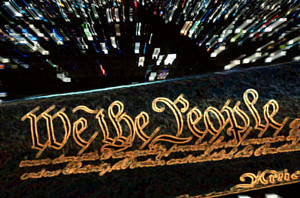E-Speech: The (Uncertain) Future of Free Expression
As tools like the Web, e-mail, voice over IP, Internet video, mobile phones and peer-to-peer file sharing become increasingly vital to our lives, limitations on speech and threats to our privacy are becoming increasingly important civil rights issues.
By Aram Sinnreich and Masha ZagerImagine this: It’s the day before your daughter’s birthday. She lives in another state, so you make a video of the rest of the family singing “Happy Birthday to You” on your camcorder and put the videotape in a box with her address on it. But at the post office, you’re told the box will take two weeks to deliver unless you pay your daughter’s local mail carrier an extra delivery fee.
So instead, you write her a letter describing the video and including the lyrics to “Happy Birthday to You.” She never receives the letter; unbeknownst to you, the post office has opened it en route, and, seeing that you’ve enclosed copyrighted materials (yes, the “Happy Birthday” song is copyrighted), has decided not to deliver the envelope to her. You write her another letter, without the song lyrics, and although it arrives on her doorstep intact, she can’t open it because you used a large manila envelope and her electric letter opener works only on size A2, A6 and A7 envelopes.
You decide to fly out and deliver your birthday wishes in person. After the usual hour-long wait at the airport, you reach the metal detector. A TSA officer asks you to come to a private room, where you are searched and questioned, and left waiting for six hours. The airport security officers repeatedly ask you about your plans for a future visit to China, which is strange, because you mentioned these plans only once, during a private conversation with a friend.
Finally you are allowed to board a plane, and a few hours later your daughter meets you when you land. You give her a big hug and try to sing “Happy Birthday.” However, when you open your mouth, no sound comes out. You can speak perfectly well, but for some reason you are unable to sing.
If this scenario sounds absurd, that’s because it is. If it sounds unrealistic, that’s because you haven’t been paying attention. Although no one is slowing down or opening your posted letters, spying on your face-to-face conversations or restricting your physical ability to make music, all of these barriers to free speech — and more — are becoming increasingly prevalent in the world of digital communications. And as tools like the Web, e-mail, voice over IP, Internet video, mobile phones and peer-to-peer file sharing become increasingly vital to our relationships with family, friends, colleagues, businesses and government institutions, these limitations on speech and threats to our privacy are becoming increasingly important civil rights issues.
When we talk about unequal access to computers and other digital communication technologies, we speak about the “digital divide.” When we talk about the concentrated ownership of the Internet access business, we can point to a simple, powerful statistic: Four companies control nearly 60 percent of the American ISP market, and four companies control nearly 90 percent of the American mobile phone market. But there’s no simple way to talk about the interrelated issues of electronic surveillance, network neutrality, asymmetry and “walled garden” technologies that collectively threaten free expression in the digital world.
Without a name for the big picture, it’s difficult to do anything about it. Imagine trying to reverse global warming, reduce pollution and save species from extinction without the umbrella of the word environmentalism connecting the issues. Therefore, we propose the term e-speech as a concept to unite these issues, and to discuss potential solutions to the problem they collectively pose. First, however, we should briefly discuss the issues themselves.
Most of us have read about the surveillance of our phone conversations, and the recent amendment to the Foreign Intelligence Surveillance Act (FISA) retroactively granting immunity to companies like AT&T and Verizon for illegally handing our private information over to the federal government. However, fewer people are aware of the Stored Communications Act (SCA), which the government has used to obtain access to Web-based e-mail without getting a warrant or notifying the account holder.
Similarly, the Anti-Counterfeiting Trade Agreement (ACTA), an international treaty currently under negotiation, may allow customs officials to search our computers, MP3 players and other electronic devices for unpermissioned content when we travel, and may force ISPs to disclose more information about our online activities to copyright owners claiming infringement. ACTA negotiations have been held in secret, and what little we know is the result of leaks. Despite not telling us much about it, the Office of the United States Trade Representative (USTR) says it is trying to “complete the new agreement as quickly as possible.” The Electronic Frontier Foundation and Public Knowledge recently filed suit against the USTR, demanding more information about ACTA before it’s actually ratified.
Another potential threat to civil liberties online is the end of network neutrality, or nondiscriminatory delivery of online communications. Some ISPs have begun to argue that they should be allowed to collect an extra fee from the application provider for delivering an e-mail, Web page or video to an end user. Former AT&T CEO Ed Whitacre summed up their justification well, arguing that “for a Google or Yahoo or Vonage or anybody to expect to use these pipes [for] free is nuts!” However, this argument doesn’t hold much water when you consider that both the originator and the end user are paying for their Internet access; in essence, the ISPs would like to get paid by three separate parties to deliver a single e-mail or voice message from point A to point B.
In reality, the purpose of such fees would be to protect ISPs’ video services from competition by Internet-based video (such as YouTube), and ISPs’ phone services from competition by Internet-based VoIP (such as Skype). And for any Internet communications that did take place, major publishers and advertisers could outbid the rest of us, consigning us to the slow lane. In the short term, this could make Web-based services like audio/video chatting and video sharing more expensive. In the longer term, it could bring an end to the proliferation of new voices and creative new services that we’ve gotten used to seeing on the Web.
There is no legislation supporting or rejecting net neutrality (this may change soon; several bills have been introduced on both sides); however, net neutrality currently stands as Federal Communications Commission policy. Even so, there are many cases in which Internet providers have apparently broken the rules. Most famously, Comcast, the nation’s second-largest ISP, was caught throttling bandwidth for customers who used the BitTorrent file sharing protocol. Although the FCC ruled that the company had to stop, Comcast has appealed the decision. In the meantime, Comcast has amended its broadband user policy, capping monthly usage at 250 gigabytes (not much for fans of digital video).
Yet another hindrance to free speech and open communications online is asymmetrical access (the “A” in “ADSL”). Nearly all broadband ISPs — even in the age of YouTube, Skype and MySpace — offer downstream speeds (from the Internet to the user) that are much faster than upstream speeds (from the user to the Internet). This is a legacy of the cable networks’ origins in the unidirectional world of TV programming, and of the antiquated vision of the Internet as an “information superhighway” by which consumers would access information. Few people anticipated that Americans would be as interested in producing content as they were in consuming it, or that they might want to use video for communicating. So regulators failed to address communication to the Internet, and the original vision of the Internet became enshrined in industrywide technology standards. Today, most providers still use technologies that are downstream-oriented. A few new technologies (Active Ethernet, GPON, VDSL2) support high upstream speeds, but it will take years, and hundreds of billions of dollars, to upgrade all of our networks to use them.
Finally, free speech online is threatened by “walled garden” services and technologies, in which the ISP or wireless provider determines what content the user has access to, what software the user can install, and even what formats are permissible for encoding audio or video. Walled garden services for the PC had their heyday in the 1990s (remember AOL, CompuServe and Prodigy?), but we are only beginning to see the extent to which they will dominate the Internet on wireless devices.
A great example of a walled garden is Apple’s iPhone. Spending several hundred dollars to purchase one doesn’t give you permission to install the software of your choice or distribute software to other users. Apple has already used its power to block software providers attempting to compete with Apple’s own software, such as the e-mail application that comes bundled with the device. Even more worrisome, Apple CEO Steve Jobs has acknowledged that iPhones are equipped with a “kill switch” that allows the company to remotely delete applications from your phone. The company calls this a last-ditch security protocol to disable malware, but it comes at the cost of consumer control. Imagine if General Electric could remotely remove food from your fridge that it deemed unsafe. Now imagine that GE is also one of the top providers of meat, cheese and veggies to American supermarkets. Clearly, this is not a combination in the consumer’s best interest. (To be fair, most wireless phones have even more “walls” and less “garden” than the iPhone does.)
What are we to do about these threats to liberty, privacy and autonomy in the digital world? In view of the problems we’ve discussed, unfettered Internet access requires either:
• Laws that strictly protect digital privacy and net neutrality, deter abuse of market power, and encourage investment in new ultra-broadband technologies; or • User-owned or unmanaged networks with very-high-speed connections.
For the sake of argument, let’s dismiss the first of these as impractical, or at least unlikely in the current political climate. But how about the second?
In theory, you could buy a length of fiber optic cable (which can support tremendous symmetrical bandwidth over long distances) and run it directly from your house to the nearest Internet point of presence (POP). You then buy an electronic gadget for each end of the cable. You plug one gadget into your computer and the other one into the Internet. Now you can upload and download whatever you like, and there’s no ISP to tell you what you can or can’t do — or turn over your records to some inquisitive government agency.
Is this any more feasible than passing a bunch of laws opposed by telecom providers? Well, not exactly. It’s expensive, and complicated. It won’t work unless there’s also fiber at the POP. And what will your neighbor say when you run your cable through her backyard?
The solution would be viable if you were, say, a hospital with a lot of money and an IT staff and a need to upload and download gigantic medical image files. In fact, customer-owned fiber is a reality today for such large organizations. For smaller companies, however, “condominium fiber” may be a better option. Condo fiber providers install the fiber backbone and negotiate rights of way with the neighbors. Then they sell individual strands of fiber to their customers and collect a small annual maintenance fee.
For individuals, no such solution has been developed. But different organizations are inching toward it from different angles, and if we can take the best aspects of each approach, an e-speech solution might emerge. Here are four of the partial solutions being proposed:
• In Canada, CANARIE — the public/private organization that runs Canada’s advanced research network — is trying to jump-start a residential condo fiber project. Bill St. Arnaud, CANARIE’s chief research officer, asked residents in an Ottawa neighborhood whether they wanted their own fiber connections to the Internet; about a third said they did. He then convinced a business fiber provider to run a trunk line through the neighborhood, and to agree to run a connection to the nearest Internet POP for any neighborhood resident who could pay about $1,500. He also worked out a complex financing scheme (he calls it “green broadband” — don’t ask) to make the fiber easily affordable for those who can’t buy it outright.
At the POP, customers will have to connect their fiber to an ISP’s equipment. In theory, customers can choose among ISPs. But there’s a slight hitch: As of this writing, no ISPs have agreed to participate.
• Many Swedish cities operate publicly owned systems that work in ways similarly to the CANARIE scheme. These municipal fiber networks are open to any ISP — some have dozens of competing ISPs — and the operator will run fiber to any building where the owner pays for a connection. Individual homeowners finance their fiber connections by adding around $10 to their monthly mortgage payments (a better investment than granite countertops in terms of resale price). As in the CANARIE plan, customers can decide whether and when to install the fiber; once connected, they can change ISPs at the click of a mouse. This model is starting to catch on in other European countries, such as the Netherlands. In the U.S. there are about 60 municipal fiber networks — some states allow them, others don’t — and a few have succeeded in attracting multiple ISPs. None of them, however, put the customer in charge of connecting to the network, even though customer-controlled fiber helps attract ISPs due to the low investment costs and high degree of customer loyalty.
• A company called Copowi (short for Community Powered Internet) was launched in 2007 as the first strictly “net neutral” ISP. It now offers broadband services in 12 Western states over DSL lines wholesaled by Verizon, AT&T and Qwest. Copowi promises not to block, degrade or modify data or to discriminate for commercial advantage on the basis of source or destination — with exceptions for necessities such as spam prevention and, of course, law enforcement. It also provides encryption for e-mail and Web surfing, both to help users protect their privacy and to make it more difficult for network owners to implement non-neutral access.
After a year in business, Copowi has about 4,000 customers, according to founding partner George Matafonov. Eventually it would like to partner with more network owners or even to build its own networks, but first it needs to develop a larger subscriber base, which isn’t easy for a niche player.
• New “mesh” wireless networking gear — which lets people share Internet access something like BitTorrent lets them share files — has made it easy and inexpensive to create decentralized networks. Wireless mesh networks are now being used in locations as diverse as low-income housing projects, Indian reservations and South African schools. Citywide (or nearly citywide) mesh networks are being built in places like San Francisco and Urbana, Ill. Internet access becomes much less expensive because neighbors can share a commercial DSL connection in the same way that co-workers in an office do.
However, mesh networks tend to be less decentralized in practice than they are in theory, and for technical reasons any really large mesh network seems to require a degree of structure and management. And even a decentralized mesh network is dependent on an ISP to communicate with others outside the neighborhood.
All of these efforts offer partial solutions to the problem of guaranteeing free expression over digital networks. Remember that the components of the problem we identified include unwarranted government intrusion; ISP self-dealing (net neutrality and the walled garden); and asymmetry. Looking at each of the solutions in turn:
Private condo fiber, if it ever exists, will solve the asymmetry problem nicely and give the customer some ammunition against ISP self-dealing. However, it will do nothing to combat government intrusion.
Public condo fiber (the Swedish solution) will face an uphill battle in the U.S., where phone and cable companies routinely delay municipal broadband projects with nuisance lawsuits and sometimes derail them altogether with legislation. However, when public fiber networks are built, they solve the asymmetry problem. And, if they attract competing service providers, they may help counter ISP self-dealing. Also, local governments may be able to stand up to unwarranted federal law-enforcement demands more effectively than private operators can, though the odds of this aren’t great.
Net neutral ISPs (such as Copowi) are a terrific solution to net neutrality and walled-garden problems, but they can’t address the asymmetry issue because they rely on existing network technology. This solution also fails to address governmental intrusions on privacy, because Copowi is legally obligated, just as AT&T, Comcast and the other large ISPs are, to cooperate with these intrusions.
Decentralized wireless mesh networks offer some hope of protecting freedom of communications within the network, if not between the network and the public Internet. As community wireless activist Sascha Meinrath writes, “What happens when a group of friends get together and buys a single line that is then shared among them? What happens when an apartment building buys a line and shares it? What happens when a community or neighborhood gets a line and shares it? … Who ‘owns’ an ownerless network? Because that (non)entity is required by [law] to provide surveillance capabilities on that network … [it] represents an unenforceable mandate.”
But wireless mesh networks are not well equipped to handle the other problems we’ve discussed. Because a wireless network can’t communicate with the Internet until it finds a wire, it is dependent on a single ISP. Ultimately it is limited by the ISP’s access speeds and network management policies.
If wireless devices were ever to become powerful and prevalent enough for the mesh to replace much of the Internet as we know it, every mobile phone and laptop could become a voluntary peer in a global community of equals, without oversight or restrictions. Alternatively, if virtualization, a technology that slices up computers into multiple “virtual” machines, is ever successfully applied to the hardware at the Internet POP (right now it’s busy transforming the corporate data center), we could conceivably all afford to be our own ISPs someday. But the limitations of current technology — as well as the opposition of ISPs and telcos, fighting to fend off what they see as a doomsday scenario — make these blissful utopias unlikely anytime soon.
In the meantime, keeping in mind our mantra of “e-speech,” we can continue to push federal regulators and access providers to support net neutrality and lower their garden walls, and we can continue to experiment with new models for community-owned and decentralized access. Most important, however, we have to remain aware of our civil liberties in the Digital Age, and to realize how easily — and invisibly — they can be removed.
Your support matters…Independent journalism is under threat and overshadowed by heavily funded mainstream media.
You can help level the playing field. Become a member.
Your tax-deductible contribution keeps us digging beneath the headlines to give you thought-provoking, investigative reporting and analysis that unearths what's really happening- without compromise.
Give today to support our courageous, independent journalists.





You need to be a supporter to comment.
There are currently no responses to this article.
Be the first to respond.